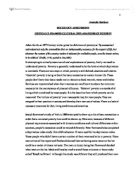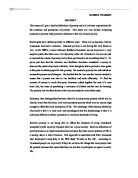Cultural poverty links economic deprivation and marginalisation, and the politics and culture of society. In other words people can be poor because of their social exclusion from society. A cultural explanation looks at how health inequalities are rooted in the behaviour and lifestyles of the individual and that those suffering poor health have different attitudes, values and lifestyles which mean they don’t look after themselves. Even though these adults know the adverse affects it will have on their health, they continue with this lifestyle because to them it is a way of coping with the everyday stress that living in poverty has on them. Cultural explanations pinpoint the cause of poverty and suggests that the poor are individuals who have been badly socialised that they possess deviant values or they are part of a deviant subculture.
Some sociologists use the term ‘underclass’ to designate the poor. Marx and Engels referred to these people as
‘the ‘dangerous class’, the social scum, that passively rotting mass thrown off by the lowest layers of old society’ Communist Manifesto 1848
The Underclass Theory emphasises the subculture and the attitudes and behaviour of the underclass. To be labelled as the ‘underclass’ there are several categories taken into account – dependency on welfare, crime, teenage pregnancy, high truancy rates, permanent unemployment and drug addiction This explanation of poverty argues that the poor subculture is inherent. The poor are said to be part of a subculture which is antagonistic to the mainstream culture of society. The ‘culture of poverty’ thesis by Lewis (1968) made an observational study of South American peasant cultures. He argued that the poor have a distinctive set of attitudes, norms and values. These norms are then transmitted to each new generation creating a poverty stricken subculture which is independent of the rest of society. As a result the poor are unable to see the benefits of increasing living standards because they are conditioned to accept their situation and unwilling to make the effort to change it. Lewis also argued that middle class researchers might find it hard to understand this way of life which provided positivism for the poor people and therefore it would be perpetuated. A concept of this is that people are in poverty because of their own behaviour and attitudes, or that of their parents. Fatalistic attitudes lead to failing to take up opportunities. The people live life for the moment and their poverty is due to their culture.
Lewis’s thesis was criticised by some sociologists as it ignored structural causes of deprivation. Sir Keith Joseph argued that there was a ‘cycle of deprivation’ and he saw culture as a key element. It let society off the hook and labelled the poor as culturally deficient. It was however adopted by the New Right thinkers. David Marsland claimed that the underclass benefited from the economic growth of Britain without contributing to it. The cultural explanation being that the welfare state creates a lack of incentive for the poor to seek paid employment. Therefore the more privileged members of society justifiably enjoyer higher standards of living as they work hard to achieve them. They also fund the welfare state via national taxes and as a result the poor receive financial support by proxy from the middle and upper classes.
Zymunt Bauman has recently cast doubt on this presumption that there is an underclass with ‘deviant’ values. He suggests that in fact the term ‘underclass’ is an ‘invented category’, which, sadly, belongs:
“..to the imagery of a society which is not all-embracing and comprehensive…Underclass evokes an image of a class of people who are beyond classes and outside hierarchy, with neither chance nor need of readmission; people without role, making no useful contribution to the rest, and in principle beyond redemption.” (Page 66, Z.Bauman (1998) ‘Work, consumption and the new poor’ Open University Press).
Lawrence Mead claimed that the poor did not want to work. They did not want to take on poorly paid jobs as they would be better off living on benefits. However by not working also meant that they did not have the experience to take on the better paid jobs when they became available. There are many critics of poverty and Marxists would condemn Lewis’s comments as his observations cannot be generalised to western industrial societies. Marxism suggests that the poor are victims of a biased, capitalist system rather than the cause of their own poverty. The government claims to seek economic equality using methods such as progressive taxation, the threshold of which may not even be reached by the poorest members of society. They would condemn the studies as an excuse to blame the poor and exonerate the capitalist system which exploits the poor to the advantage of the economic elite. The poor are unable to seek the higher living standards of the privileged majority because the system is biased against them. Poverty stricken groups are subjugated by the bourgeoisie in order to glean extra profits and capital via labour exploitation.
Charles Murray presents a similar argument in his study of the American underclass. He argued that it was not so much the degree of poverty but the type of poverty. The category of birth outside of marriage is very high among the lower classes and he took this as a symptom of social decay as it represented the typical underclass family. This subculture of poverty does not seek elevation to privileged society as it functions using it own norms and values whilst receiving financial support from a wider society.
The report ‘Monitoring Poverty and Social Exclusion 2002’ published by the Rowntree Foundation shows that there is ‘some recent progress on income poverty, but a long way still to go’. There are now a large number of people who are economically inactive but want paid work, many of whom are sick or disabled. This poses a serious challenge to the strategy of reducing poverty by encouraging people into work. This is reinforced by the lack of change in the number of long-term workless households which has remained at about 2 million since 1996.
In conclusion, the welfare state presents a simple and easy way of life to these groups and as such they are reconciled to their poverty. The logical conclusion would be to disestablish the welfare state in order to prevent this. This cause of action would force the poor to seek employment in the labour market where they could a) contribute to Britain’s economy and b) subsequently improve their standards of living.
Word Count 1471
BIBLIOGRAPHY
Books and Journals
Kirby et Al Sociology in Focus Causeway Press
Taylor et Al Sociology in Perspective (QUA Edition 2000) Heinemann
Palmer et Al Monitoring Poverty and Social Exclusion 2002 Rowntree Foundation
Sociology Class Notes 2002
Websites
Accessed on 2nd January 2002







